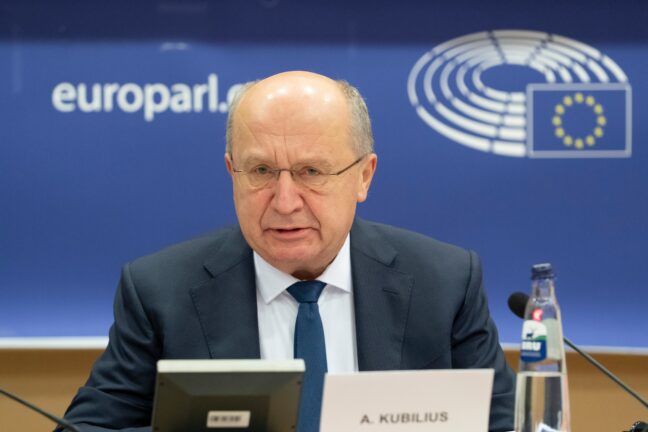Brandishing what he calls a defence “big bang”, EU defence commissioner Andrius Kubilius told MEPs that a late-night ‘mini-omnibus’ co-legislators’ agreement will reroute cohesion cash and industrial tools toward a €800bn surge in military spending. This will, he says, help end Europe’s dependence on American muscle for good.
Andrius Kubilius, the European Union‘s defence commissioner, gave the phrase ‘big bang‘ new energy when he faced the Parliament’s security and defence committee (SEDE) on November 6th. “We created opportunities for member states to increase defence spending till 2030 by additional 800 billion euros,” he beamed. Yet cash was only part of his pitch. He argued that the machinery for turning money into muscle is finally in place.
Mr Kubilius treated the committee as a familiar audience. “It’s again a pleasure and honour to be back…almost like feeling coming back home,” he said. He tabled an annual progress report on simplification, implementation and enforcement, and insisted that the past year had been about laying foundations. Now comes delivery. The commissioner claimed that late-night talks had produced a “mini-omnibus” deal that would channel cohesion funds into defence programmes.
A ‘mega outcome’
The Union’s defence chief, along with the entire European Commission, welcomed the deal, “a mega outcome”, in his words. It opens the possibility for Ukraine to be associated with the €7.3bn European Defence Fund (EDF). This represents an important step forward in EU–Ukraine defence cooperation and in strengthening Europe’s collective security and industrial resilience. It also paves the way for Ukraine’s gradual integration into the European Defence Technological and Industrial Base (EDTIB).
The co-legislators provisionally agreed to allow the so-called EIC Accelerator to support dual-use and defence innovation. The Digital Europe Programme (DEP) will also expand to dual-use applications, while the Connecting Europe Facility (CEF) will be adapted to better support investments in military mobility. The regulation also amends the EDF to support the development of the European defence industry and allow more agile support to disruptive technologies for defence.
You might be interested
The headline promise is “European independence through European defence readiness 20-set”. The slogan that still lacks an agreed date but carries a clear meaning: Europe must deter without day-to-day American help.
The money flood
Europe’s treasuries have noticed the mood. Alongside the EU’s extra €800bn to 2030, NATO has urged members to lift defence outlays to 3.5 per cent of GDP by 2035. If capitals keep that pledge, said Mr Kubilius, they will pour €6.8tn into arms over the next decade. Even if only “30, 40, or 50 percent” becomes real investment, the sums dwarf anything Brussels can muster.
The commissioner drew an unvarnished comparison. The next seven-year EU budget proposes €131bn for defence and space, of which perhaps €70bn will reach armaments. “The difference is 100 times,” he reminded MEPs. The union’s cash therefore serves as a lever, not a substitute, for national wallets.
We need to have our own reporting system in order really to check if we are able to do what we are planning. — Andrius Kubilius, European Defence Commissioner
He stressed speed. Member states must file national investment plans by month-end. Money will start flowing in the first quarter of 2026, he promised, thanks to an EU “escape clause” that frees budgets from peacetime debt rules.
From design to production
Brussels also wants industrial heft. The new European Defence Industrial Programme, or EDIP, should become operational early next year. Its kitty is only €1.5bn, but Mr Kubilius called the policy tools revolutionary. They include joint projects of common European interest, streamlined procurement rules, and the power to raise debt. A parallel “simplification omnibus” will slash factory-building permits from four years to two months.
Those frameworks feed into a Roadmap for Defence Readiness 2030. The document fixes targets for contracts, production and defragmentation of industry. It assigns leading nations to each capability coalition and relies on the European Defence Agency to co-ordinate. Pan-European arms schemes have often flopped. The roadmap, therefore, carries a built-in reporting system to expose laggards. “We are planning…we need to have our own reporting system in order really to check if we are able to do what we are planning,” the Lithuanian commissioner said.
The plan highlights four flagship projects: a European Drone Defence Initiative, an Eastern Flank Watch, an Air Shield and a Space Shield. The council has already declared the first two urgent. Southern capitals, meanwhile, float the idea of a Mediterranean flank watch. The commission will act as “one-stop shop” for each flagship, smoothing finance and licences.
Ukraine at the core
In a separate but related development, the Parliament’s committee on budgets approved its largely favourable opinion on the Readiness 2030 initiative on Wednesday. The report, with MEP Lucia Yar (Renew/SVK) as rapporteur, stresses that European defence readiness is still falling short. “Our priority must be linking European planning and budgets – today we have 27 national defense strategies but no common European capacity map,” Ms Yar previously told EU Perspectives. The report passed with a comfortable 22:5 margin, with five abstentions.
War still rages on the EU’s border, so Kyiv anchors many of Mr Kubilius’s ideas. He backs a “reparation loan” funded by frozen Russian assets to show Moscow’s strongman Vladimir Putin that aggression will not pay. Thirteen member states intend to tap EU safe loans for fresh aid to Ukraine. A Ukraine Support Instrument sits inside EDIP, and the freshly minted mini-omnibus grants Ukraine associate membership of the European Defence Fund.
Partnership runs both ways, the commissioner insisted. Ukraine’s tech firms can bolster EU schemes such as the drone alliance or Eastern Flank Watch. A joint growth forum under the title Brave Tech EU will spread know-how. “Ukraine can help us very much with their technological achievements,” he said.
Delivery matters
Next on the commission’s docket is a military-mobility package and a defence-transformation roadmap, due within weeks. Early 2026 should bring a revised defence-procurement directive and a paper on a space-defence shield. Each step, said Mr Kubilius, will move Europe from planning to “big bang delivery”.
Our priority must be linking European planning and budgets. Today, we have 27 national defense strategies but no common European capacity map. — MEP Lucia Yar (Renew/SVK)
The commissioner said that Europe cannot rely forever on allies. National capitals must spend wisely, industries must merge and Brussels must prod both. His closing argument put it bluntly, Europeans have their work cut out: “For next year, we’re looking into a vision of defense and security procurement directive, and also communication on single market, and communication on the space defense shield.”
Talk comes easily in Brussels, money a little less so, and hard power hardest of all. But if Mr Kubilius’s timetable survives, Europe’s defence union will look far more substantial by 2030. Delivery, he said, is now the only acceptable metric.





